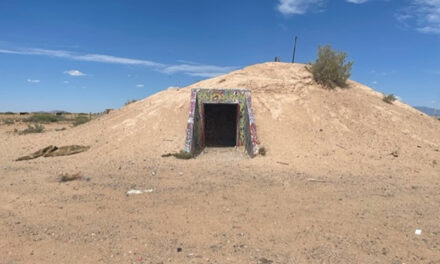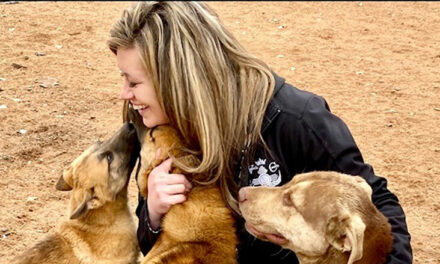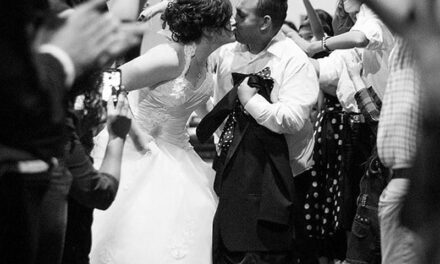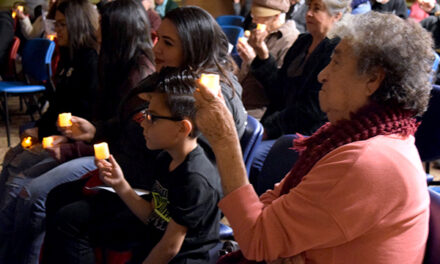BELEN — As a team of bio-archeologists plans to return to the Hub City this summer to continue their dig at the Plaza Vieja — Belen’s Old Town and location of the original Our Lady of Belen Catholic Church — project historian Samuel Sisneros took time recently to give a lecture about not only the history of the project but what he calls Belen’s emergence story.
Before becoming an archivist/historian for the Center for Southwest Research at the University of New Mexico, Sisneros was a genealogist and traced one of his maternal lineages to Belen natives living at the mission plaza in the 1790s.

Julia M. Dendinger | News-Bulletin photo
Local historian Samuel Sisneros speaks about the emergence of the community of Belen and the history of the original Our Lady of Belen Catholic Church. Behind him are the original plans of the church.
Determined to find evidence, knowledge or documentation of the colonial village of Belen for a documentary project, Sisneros went to the Belen Harvey House Museum, where he overheard a local woman talking to her granddaughter about family history.
“I started a conversation and asked her if she knew where the older, historical part of Belen was. She smiled and said she lived there, and proceeded to show me a 1905 map exhibited in the museum,” Sisneros said in 2017, the year before excavation at the old plaza began.
“The map had a rectangle drawing with the words ‘Old Town Church Ruins.’ This set me on a six-year path researching every primary document, secondary publication or oral history I could find on the early history of the pueblo of Belen and Our Lady of Belen (Catholic) Church.”
“It is my hope that archaeological excavation at the Belen site will ‘ground truth,’ what is known from documented history as presented in my research and through local oral tradition,” he said.

Image courtesy of Samuel Sisneros
The floor plan of the original Our Lady of Belen Catholic Church, which was once at Plaza Vieja on Wisconsin Street in Old Belen, was drafted in 1795.

Image courtesy of Samuel Sisneros
This 3-D rendering is an estimate of what the original Our Lady of Belen Catholic Church might have looked like, based on the floor plans of the building drawn in 1795, two years after its completion.
As the project has moved forward, Sisneros hopes to one day recreate, to some extent, the Plaza Vieja site to be a “vibrant social and educational destination” for community members and visitors, so they can discover and reclaim the “social and spiritual space,” according to his 2019 Belén Plaza Vieja and Colonial Church Preservation and Interpretive Plan.
The area of what is Belen now was home to a variety of people, including Spanish/Mestizo settlers from Northern New Mexico, Genizaro families and Native Americans with origins as slaves and servants of the colonists.
The Tiguas and Piros traversed the area regularly and were followed by the Spanish in the 1600s. In the 1730s, Genizaros began to settle in the Isleta area south to Belen. They were followed by the Spanish/Mestizo settlers about a decade later.
“There may have been periods of unity and progress but we know that there was also disharmony and strife between the pueblo peoples and Spanish,” Sisneros said during a lecture at the Belen Public Library on March 26.
During the Pueblo Revolt of 1680, most Spaniards left the area and went to Mexico. They returned in 1693, again settling in the same areas they previously occupied including the Belen area.
In the early 1730s, church records begin reflecting the Genizaro families in the area, and in 1733 several Genizaro families, comprised of about 70 people, petitioned the Spanish for land in the old, abandoned town of Sandia but it was denied. Most of those families moved south and formed the first settlement in Belen.
They were followed by a group of Spanish/Mestizo people from Albuquerque and northern New Mexico, who moved into the Belen Genízaro settlement and petitioned for the Spanish land grant of Nuestra Señora de Belen, which was given in 1741.

News-Bulletin file photo
In the first year of excavation at Plaza Vieja in Belen, part of the foundations of the original Our Lady of Belen Catholic Church was discovered.
Four years later, Belen Genizaro leader Antonio Casados with Manuel de la Cruz, the chief war captain of New Mexico’s Indian Pueblos, traveled to Mexico City to complain to the Spanish Viceroy about Spanish encroachment on their lands and abuses toward the Genizaros and Pueblo Indians.
“After nine exhausting days of testimony, the issue was apparently put to rest and both groups, the Spanish and Genizaro, returned to Belen,” Sisneros said.

Images courtesy of Samuel Sisneros
A map from 1905, above, shows the location of key buildings in Belen in relationship to the old church. Based on historic documents, community and individual memories, San Sisneros, the project historian for the archeological dig at Plaza Viejo on Wisconsin Street in Belen, estimates the below image was the footprint of the original Our Lady of Belen Catholic Church at the site.

In the 1750 census, there was 152 people living in Belen but they were in two separate, distinct communities — the Genizaro and the Spanish/Mestizos with their Indian servants. The total population was split 53 percent Indian and 47 percent Spanish and Mestizo, as the servants were also counted.
The next census in 1790 shows the population of the area growing but it also indicates a blending of the two populations. By then, the population was 57 percent Spanish and 24 percent Native American, with the remaining 19 percent designated Mestizo.
“So, that tells you that people were intermarried by 1790, if people were starting to be listed as Mestizo,” Sisneros said. “By then, the area was in the early stages of blurring ethnic and class designations.”
The building of the mission church of Nuestra Señora de Belen began the following year, and was blessed as a consecrated space as a parish in 1793.
For at least 100 years, the church was a consecrated and sacred space, with recording indicating close to 3,000 burials at and around the church.
By 1848, under U.S. occupation and ceded to the U.S. with the Treaty of Guadalupe Hidalgo, Catholic churches in New Mexico underwent a significant changes, moving from the Diocese of Durango, Mexico to the American Diocese of Santa Fe. That shift brought about the introduction of French priests to the area, including Archbishop Jean-Baptiste Lamy here in Valencia County.
It was under the direction of Lamy that the old Belen church was abandoned and a new church was built in 1860 at the current site of the Our Lady of Belen Catholic Church on 10th Street.
“Now, a lot of history books will say there was a flood,” Sisneros said. “Honestly, I’ve never seen any evidence of a flood. I’ve looked at the history books that mention a flood that made the first church fall.
“They’re using what they call an informant. Informants are important when you do research but I try to use documents, and I still not found documents to show (a flood). As a matter of fact, when I’ve talked to the archeologists, they still have not reported to me that they found evidence of a flood on the site.
“Was it conflict or a flood that made the bishop build a new church elsewhere? I don’t know. I’m still searching for an answer to that question.”

Image courtesy of Samuel Sisneros
Based on historic documents, community and individual memories, San Sisneros, the project historian for the archeological dig at Plaza Viejo on Wisconsin Street in Belen, estimates this was the footprint of the original Our Lady of Belen Catholic Church at the site.
After the church was relocated, the property came to be owned by a local family, the matriarch of which lived on the property.
In the early 1980s, Valentina Sanchez O’Neal created what the Valencia County News-Bulletin called “a museum of memory” at the property.
She turned the old house into a temporary museum, erecting colorful outdoor signs, a large gazebo and altars to mark the location of Plaza Vieja as a place of worship and prayer in Old Belen.
O’Neal even recreated the Justo Juez, imagery found on devotional candles and prayer cards. In traditional Catholicism the Justo Juez prayer and imagery is used for protection from adversaries and prayer for justice.
With permission from the family, Sisneros reached out to bio-archeologists with several universities in the hopes they would be interested in exploring the site and helping solidify the history of the church and the people of the area.
The call was answered by Dr. Pamela Stone, a visiting lecturer in anthropology at Mount Holyoke College in Massachusetts, and Dr. Debra Martin, a professor of anthropology at the University of Nevada, Las Vegas. The two have been a part of the project since the first excavation season in 2018 and are co-primary investigators.
During previous visits, the dig teams have discovered rock work consistent with the foundation of a large building, like a church, in addition to small artifacts like beads and some human remains, which will be reinterred at the current church once the dig and research on the site concludes.
Sisneros feels there are many future uses for the site, including a small capilla or small seasonal garden for the community to highlight sustainability and foods of the early Belen settlers.
Whatever may come, he hopes the Plaza Vieja will continue to embody the “duration of sacredness” of the area.

Image courtesy of Samuel Sisneros
This outdoor altar made by Valentina Sanchez O’Neal at the Plaza Vieja site was a replica of the Justo Juez imagery found in devotional candles or prayer cards. O’Neal created a temporary museum at the old church location which was open to the public until the mid 1990s.

Image courtesy of Samuel Sisneros
As bio-archeologists dig at the Plaza Vieja in Belen, they welcome community members to participate in the exploration to include the descendants of the early settlers of the area.
Julia M. Dendinger began working at the VCNB in 2006. She covers Valencia County government, Belen Consolidated Schools and the village of Bosque Farms. She is a member of the Society of Professional Journalists Rio Grande chapter’s board of directors.

















